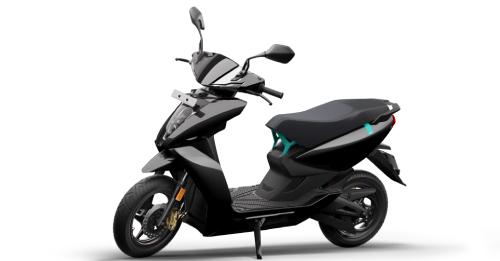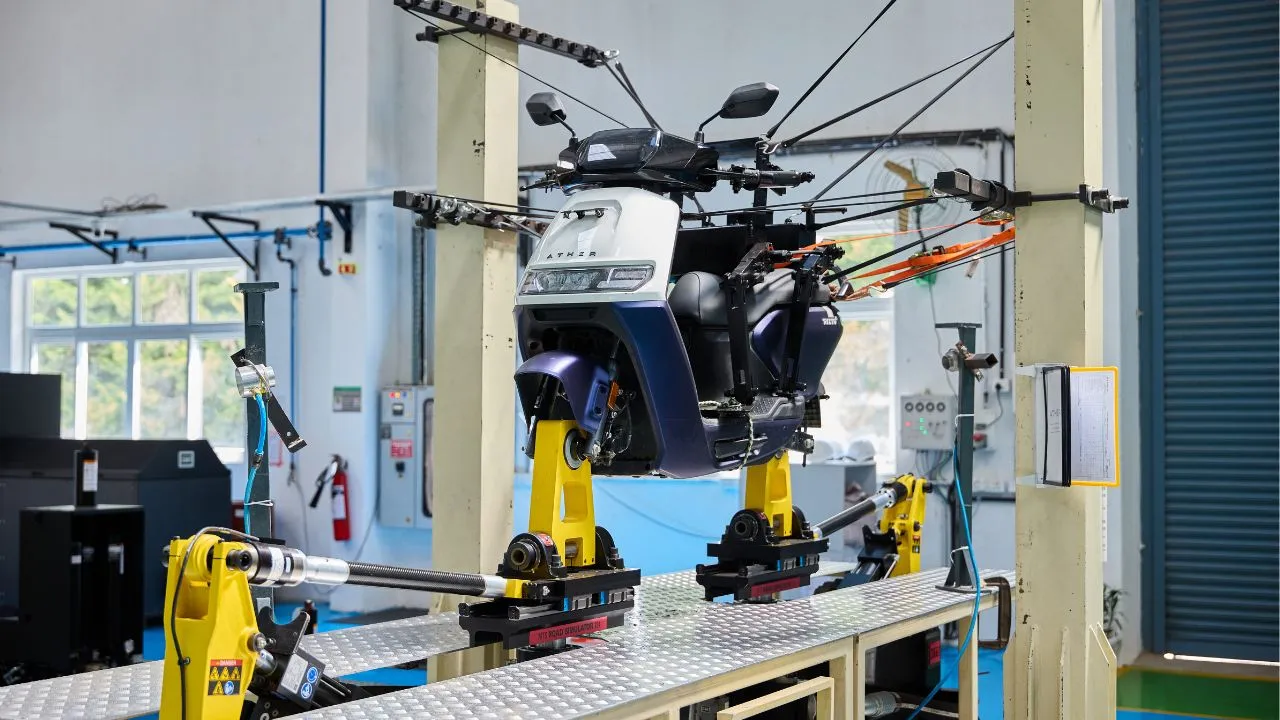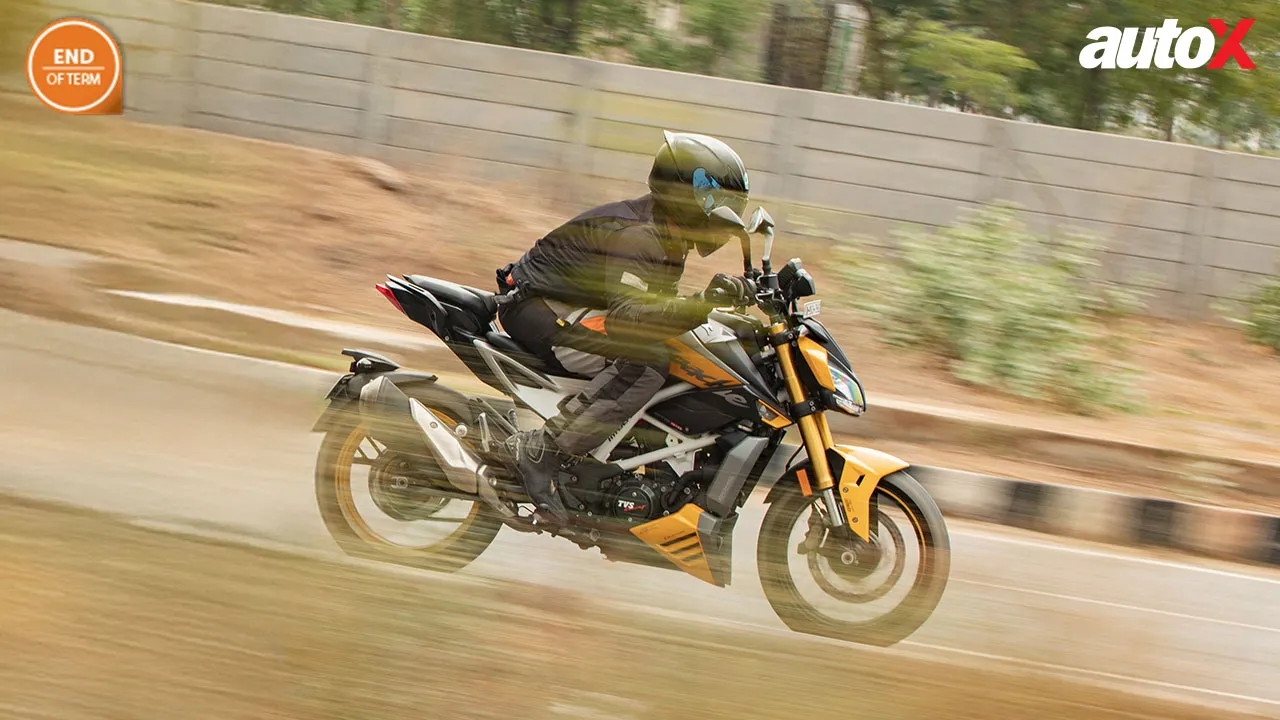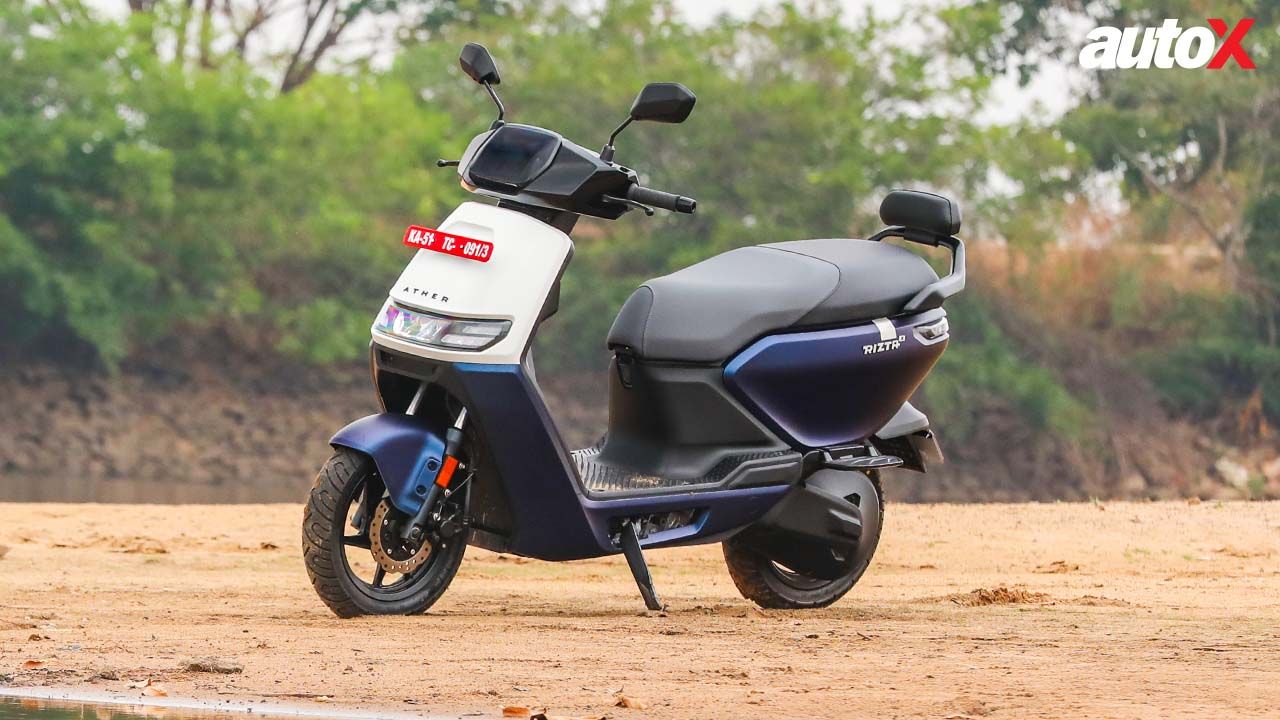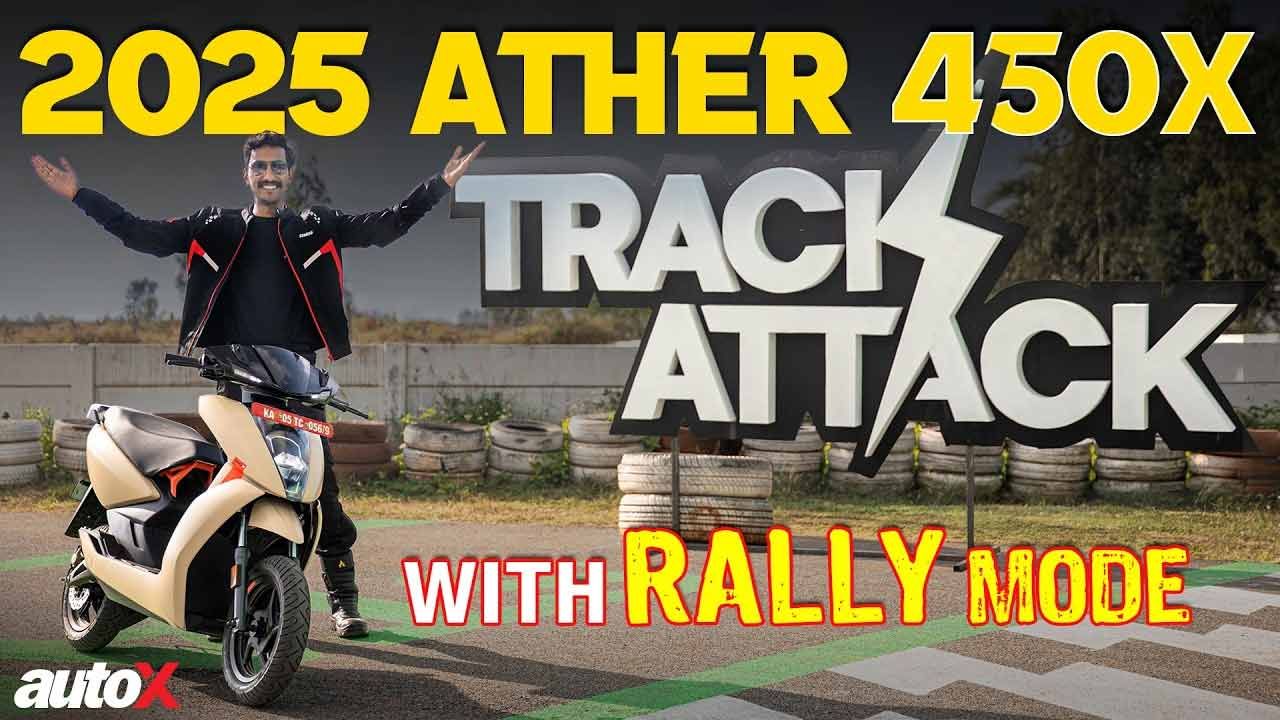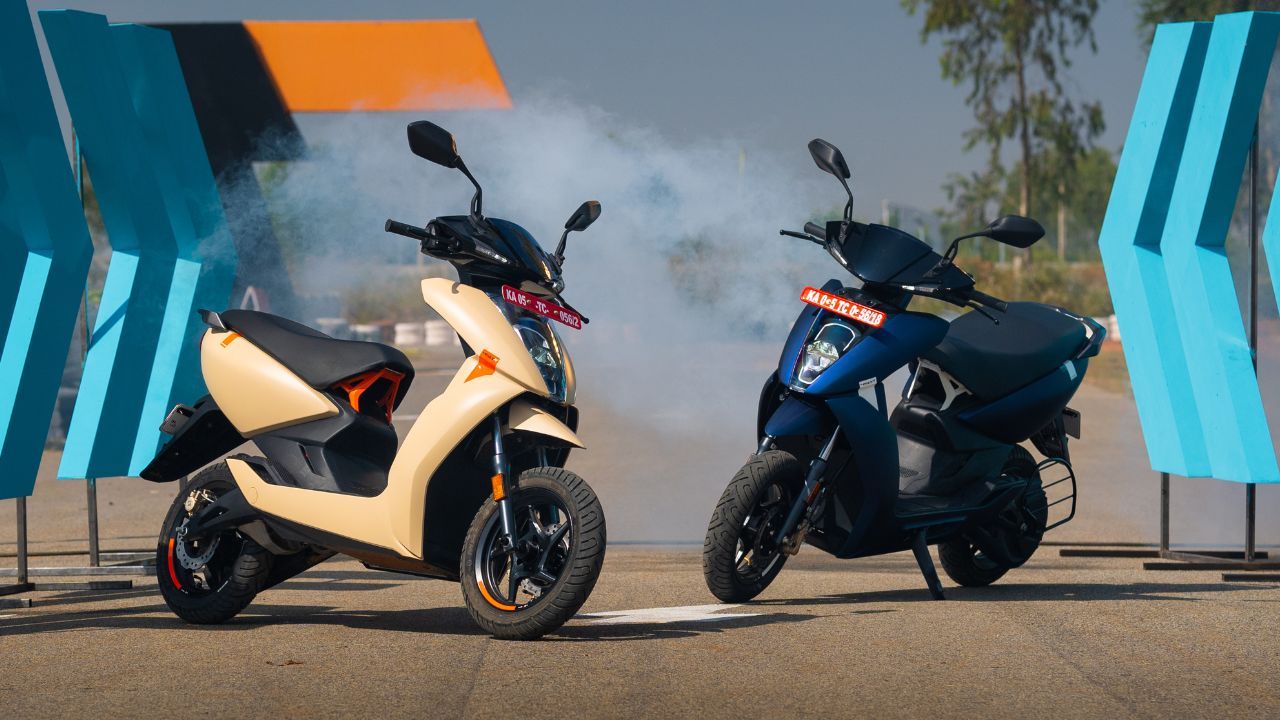Ather 450 Review: First Ride
Since every manufacturer is plunging on to electric vehicles - rather fast - we head over to Ather's HQ in Bangalore to ride the much-hyped Ather 450 and see what the fuss is all about.

We finally get our hands on Ather’s first-ever electric scooter. But does it make us want to go green?
Buying an electric vehicle is somewhat like becoming a vegan these days – in as much as both are in vogue. There are, of course, a lot of benefits of going ‘green,’ but, then, it’s a bit of a touchy topic – just like veganism – especially for old-timers. Now, to be honest, I don’t really like the idea of eating a plant-based diet as yet, but I do think that electric vehicles are evolving for the better. We now have quite interesting and capable vehicles on the market. Take, for instance, the Ather 450. It’s an all-new electric scooter, which is also the first product to have come from Bengaluru-based start-up Ather Energy.
Launched in 2018, it has become a hot topic of discussion because of its green underpinnings, connected features, and a high price tag.
The Ather 450 has also been in the news for some of the wrong reasons. You see, getting your hands on one is really, really difficult in cities other than Bangalore and Chennai. And that’s because it’s currently sold in only these two cities. However, despite its limited availability, the Ather 450 has received high praise from customers and experts alike, which, naturally, made us quite curious. So, to find out if it’s as awesome as it’s cracked up to be, we flew down to Ather Energy’s HQ in Bangalore and asked them for a unit to review. So, here’s everything you need to know.
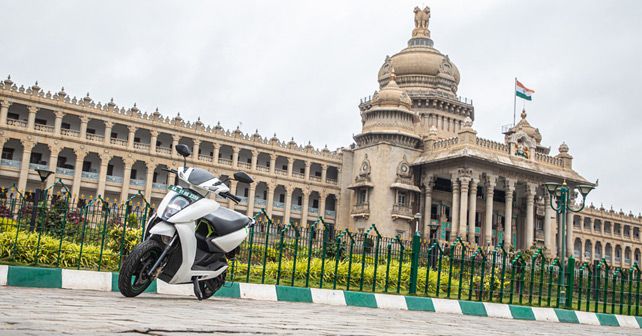
Why the fuss?
Ather launched two variants of the scooter – the 340 and 450 – in 2018, but it’s the latter that’s capturing the interest of customers. And the company is also focusing more on this variant at the moment. Now, the great thing about Ather is that it doesn’t flash the ‘green’ card all the time. In fact, Ather claims that the whole idea behind its products was to create a high-quality electric scooter that rides and handles like a conventional 125cc scooter – but with cutting-edge tech, the likes of which has never been seen in an Indian scooter before. And the fact that it happens to run on clean energy is an added bonus – not just its USP. Additionally, the main draw of the Ather is that it’s completely homegrown – the battery pack, hybrid frame, motor have all been designed and developed by Ather’s R&D team right here in India.
Clean synergy
As mentioned already, the idea behind the 450 was to make a clean scooter – but not only in terms of zero emissions. In fact, its styling follows the same philosophy, which is to say that the 450 has a neat and clean design.
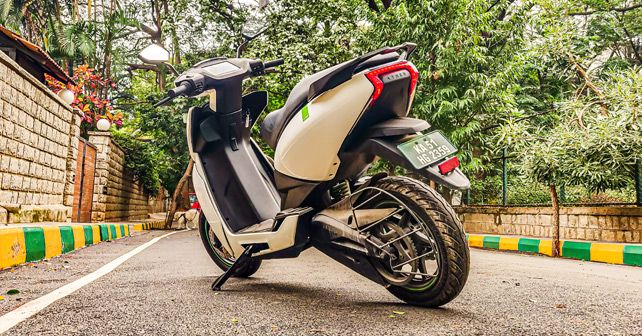
With a mix of sharply raked panels and sleek LED lighting, the 450 looks futuristic from all angles. The pointy beak, stubby rear, and 12-inch alloy wheels look pretty, and the overall proportions are right on the money. There are neither decals – apart from a green sticker with the Ather logo on it – nor any loud paint schemes. And, it’s available in any colour, as long as it’s white! What I particularly love is its strong attention to detail. Some of my favourite bits include the flush side-stand, exposed seat hinge painted in green, and integrated pillion footrests. That said, the quality of plastics around the dash could have been better.
The party piece of the Ather 450, however, is its 7-inch touchscreen instrument cluster. Put simply, this is where Ather has moved the goalposts for the competition. First up, this tablet-like arrangement is like a smartphone on the dash. Plus, it packs a raft of connectivity features, including onboard navigation powered by Google Maps. It’s a massive leap from the current crop of scooters, not unlike a jump from a feature phone to an Android Smartphone. However, surprisingly, there’s no USB phone charger here!
The touchscreen is IP65 rated – IP is an international standard for ‘Ingress Protection’ that defines the levels of sealing effectiveness of electrical devices – and it can be paired to a smartphone via an app. The scooter connects to your phone through the internet, using an in-built SIM card. Ather offers to pay for the data subscription during the first year of purchase, but, post that, you’ll have to pay from your pocket.
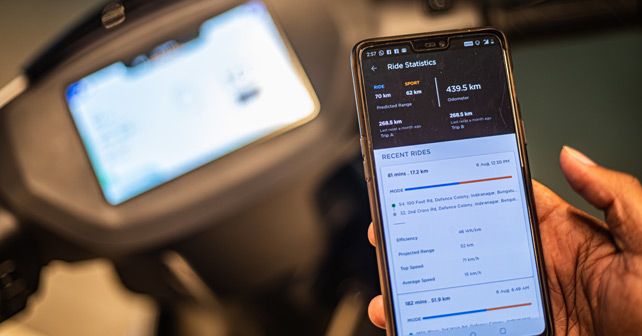
The best part, though, is that Ather’s servers are also always connected to the scooter via a cloud-based system. And this means that the company is always collecting data from each scooter using a six-axis IMU (inertial measurement unit) that monitors different riding styles, which in turn helps the R&D team to update or make changes to the software of the scooter. Based on customer feedback, and its findings, Ather has already offered around 10 over-the-air (OTA) updates for the scooter since its launch.
Another impressive thing about the scooter is that it comes with a ‘reverse’ parking mode – you can reverse the scooter using assistance from the motor. The speed, however, is limited to 2km/h in this mode, but if you hit a gradient, the motor will send more torque to the wheel.
On the whole, this whole connected ecosystem is very efficient and pretty much flawless in its application. That said, the navigation system lags at times and so does the touchscreen.

Shockingly good
The Ather 450 features a 2.71kWh (2.4kWh usable) battery pack, coupled to a 5.4kW brushless DC motor. In brake horsepower, this is equivalent to 7.2bhp. Torque is 20.5Nm, which is actually higher than most 150 – 200cc bikes! But how’s the performance?
Time-and-again, we’ve heard EV enthusiasts rave about the ‘instantaneous’ torque from zero rpm that electric vehicles deliver. Here, though, that’s not the case. Unlike other electric scooters, in which the motor is directly connected to the wheel, the Ather 450 uses a unique two-step arrangement. You see, the motor is housed in the frame, and it’s connected to the wheel via a belt-drive.
Ather says that this increases the motor’s efficiency, as the system reduces transmission losses and improves heat management. At the same time, the acceleration isn’t snappy either, which means that the 450 picks up speed like a conventional scooter.
It takes 3.9 seconds to reach 40km/h from a standstill, which is very similar to a conventional 125cc scooter. 0 – 60km/h takes 8.3 seconds, which is slightly slower though. However, in roll-on acceleration from 20 – 60km/h, the Ather’s performance is ‘electrifying’ – it’s over half a second quicker, at 4.04 seconds.
There are two modes – Ride and Sport. Suffice to say, these aren’t gimmicks – there’s a remarkable difference between the two. In Ride mode, the Ather 450 is programmed to deliver the best of both worlds – performance and range. This means that its top is speed is just shy of 70km/h, but you get a real-world range of 65 kilometres.
In Sport mode, however, the motor unleashes its full power, which means that it feels peppy and more exciting at the top-end. The top speed, as a result, is a claimed 80km/h. However, I saw 85km/h on the speedo with ease during the test ride.
The great thing is, both modes feel identical in terms of acceleration till 40km/h, but post that it’s like riding two different scooters. In Ride mode, it reminds you of a 110cc scooter – because, post 50km/h, you hit a plateau and the build-up is rather slow.
By comparison, Sport mode has no power fade after 50km/h, and it keeps on pulling – like a 125cc scooter. Ather has also announced the addition of a new Eco mode that will increase the range to 75 kilometres. My guess is that this mode will be like riding a 100cc scooter. So that’ll be three scooters all rolled into one! What more do you want from a scooter?
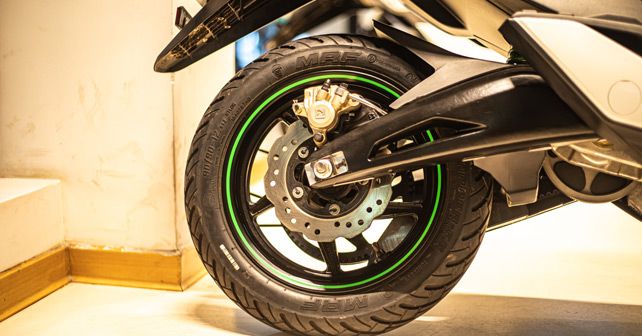
At the sharp end
The Ather 450 features a hybrid chassis, made of aluminium and steel. The battery pack is neatly stacked under the flat floorboard. Ather claims that, because the battery pack and electric motor are stacked ‘symmetrically,’ there’s virtually no lateral off-set, like in a conventional scooter. As a result, the weight distribution is nearly 50:50. This also frees up enough space in the under-seat compartment for a full-size helmet.
The chassis rests on a pair of telescopic forks at the front and a monoshock at the back, while the scooter rolls on 12-inch alloy wheels shod with MRF FG tyres. The handling is pretty sporty and quite agile in traffic. To be honest, it feels very natural. The front-end is light, the handlebar is placed high, and it steers confidently even when you’re looking to have some fun around corners.
The ride quality is on the firmer side, so you do notice undulations and bumps more often than not. However, the ride isn’t bumpy or painfully jittery like, say, that of the Aprilia SR125. Also, with a pillion on-board, the ride quality changes dramatically – it settles down and becomes more compliant.
Braking duties are carried out by a pair of disc brakes on both wheels, which also feature a combined braking system. The front brake felt sharp for the most part, but, during emergency stops, it doesn’t inspire confidence. The rear, on the other hand, is the polar opposite – it’s super sharp in its response. The moment you touch the left lever the scooter comes to a dead stop immediately. So much so that it can be a bit unnerving, but I never experienced any lock-ups. The MRF tyres also grip surprisingly well, even on wet roads.
Light on the pocket?
With a sticker price of ₹1.13 lakh (on-road, Bangalore), the Ather 450 is not a cheap scooter to buy, especially when you consider that its conventional rivals cost ₹80,000 – 85,000. However, it’s much more affordable to run in the long run. You see, according to the company, the running cost of the 450 is ₹0.30/km, as compared to that of a petrol scooter, which is at ₹1.8/km.
So, if your average run is 30 kilometres daily, you’ll end up saving nearly ₹45 every day. If you ride for 25 days a month, that’ll translate to around ₹1,100 in fuel savings. Over a year, you save ₹13,000.
In addition to this, there are no maintenance costs. In fact, at the moment, Ather is offering a free first-year subscription, which means that you don’t have to pay for your electricity bills or data plan for connectivity features either! If you work that out, within two years, you’ll recover the extra money spent at the time of the purchase. Plus, don’t forget that it’s a more advanced scooter.
But, of course, it’s not sunshine and rainbows all the time with the Ather 450 – for its battery pack will probably need replacement after 50,000 kilometres. And if you go by the above-mentioned calculations, the battery pack will last you 5 - 6 years. Right now, Ather estimates that it’ll cost anywhere between `35,000 - 40,000 to replace the battery pack. However, the company says that prices of lithium-ion cells are expected to go down in future, which will automatically bring the costs down.
Ather is also trying to come up with a buy-back or replacement policy soon. Also, the company claims that the battery pack won’t go ‘really’ dead, but will probably lose close to 30% of its capacity. And if you’re still apprehensive about the longevity, you do have the option to lease it.
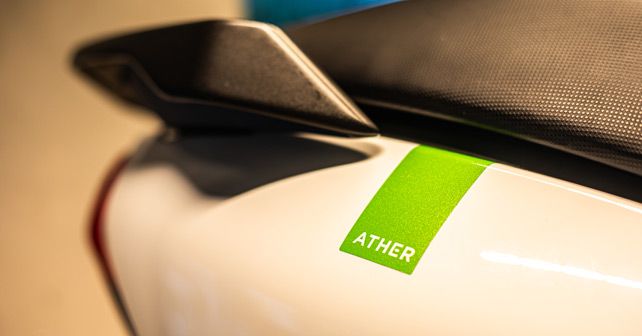
What about charging? Using the home charger that comes with the scooter, you can charge it from 0 to 100% in about 4 hours, although 80% will take just 2 hours 40 minutes. Ather has also set up fast-charging points at public places, called the Ather Grid – where you can charge the scooter at the rate of 1km/min. In Bangalore, Ather has over 30 such points, and according to the company you’re never more than 2 kilometres away from one.
Another important detail is that Ather doesn’t have dealerships, instead, they have company-owned stores called ‘Experience Centres’ – it’s quite similar to the philosophy of electric car giant, Tesla. You basically book the scooter online, but for test-rides or experiencing the product, or to take delivery of your scooter, you have to visit the store. There are no service centres, but if there’s any maintenance work, it’ll be provided to your doorstep.
Verdict
To sum it up, I must say that I am really, really impressed with the Ather 450. Sure, it took the company a long time to launch this scooter, but you have got to say that it has covered all the bases. Of course, it’s not an affordable or cheap scooter to buy, but then you’ve to understand that it offers a completely different experience to the end-user – from the sales and ride experience to connectivity features, everything about it is unique. It’s a really solid effort by Ather, and it’s unlike any other electric scooter on the market.
Is it time to go electric then? Well, after riding the Ather 450, it’s a solid yes for me!
Also read,
Ather Energy expands to Chennai
Motor: Brushless DC Motor
Battery: 2.7kwH Battery Pack
Power: 5.4kW / 7.2bhp
Torque: 20.5Nm
Charging Time :0-100% - 4hrs 0-80% - 2hrs 40mins
Price: ₹1.13 lakh (On-road, Bangalore)
X-Factor: The Ather 450 changes the rules of the game in almost every department. After experiencing this, you’ll WANT to go green!
|
Pros |
Cons
|

